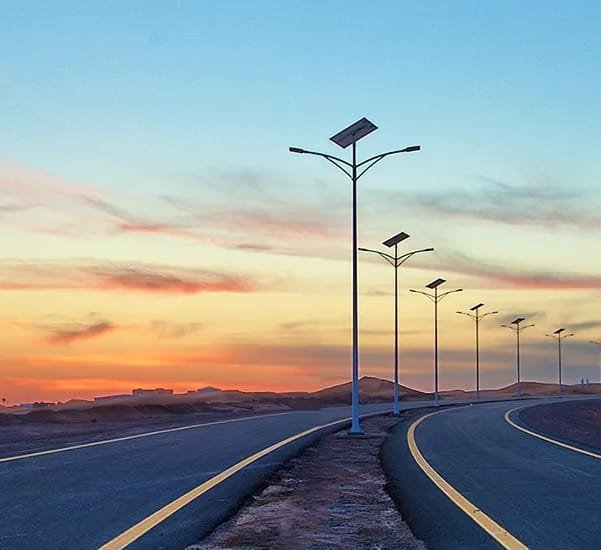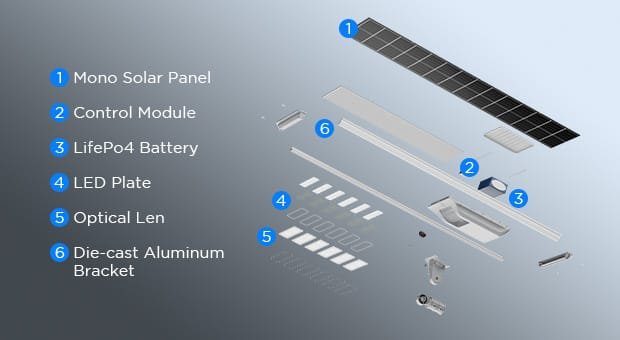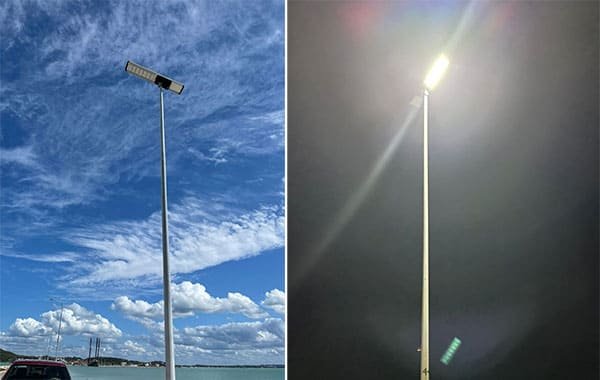Lighting failures often aren’t due to the fixture—but from poor design planning. One client installed 30 units without considering height or optics, and had to replace all of them within two months—costing thousands of dollars.
Mismatched pole height and lighting area lead to subpar brightness, reduced efficiency, and eventual system failure.
This guide reveals the technical logic behind sizing, real project mistakes, and how to pick the right light every time.
What Are All-in-One Solar Street Lights and Why Are They So Popular?
The simplicity is the genius.
All-in-One lights[^1] integrate the solar panel, LED, lithium battery, controller, and sensor—all in one unit, making setup fast and failure rates lower.
From rural Africa to industrial parks in Vietnam, these lights have become the go-to for efficient, off-grid street lighting.
Key features:
- High-efficiency monocrystalline solar panels[^2]
- High-lumen LEDs with smart sensors
- IP65+ rated enclosures
- 3–5 year lithium battery life
Height vs. Coverage: Are You Calculating It Right?
Specs look great on paper. But what happens when they go wrong?
The higher the pole, the wider the light spread—but the lower the brightness at ground level. Without enough lumens, you end up with “light in the sky, darkness below.”
Also affected:
- Beam angle and lateral coverage
- LED wattage[^3] demands bigger batteries
- Poles taller than 8m need wind-resistant designs
- Roads and plazas require different lenses
Chasing just “bright” or “wide” lighting is flawed logic.
At-a-Glance: How Much Power for What Height?
| Pole Height[^4] | Recommended Wattage | Brightness (Lumens) | Coverage Area |
|---|---|---|---|
| 3–4 m | 20–30W | 2500–4000 lm | 20–30 m² |
| 5–6 m | 40–60W | 5000–7000 lm | 30–50 m² |
| 7–8 m | 80–100W | 8000–12000 lm | 50–70 m² |
| 9–10 m | 120–150W | 13000–17000 lm | 70–100 m² |
| 11+ m | 180W+ | 18000+ lm | 100–150 m² |
The data’s clear—so how do we apply it to real projects?
More Than Watts: The Key Factors You Might Miss
- Battery size[^5]: Must last the longest nights—especially in rainy seasons
- Panel surface area: Northern latitudes need bigger panels
- Lens angle[^6]: Narrow for walkways, wide for plazas
- Smart sensors[^7]: Detect motion and dim during idle times to save power
Pro tip: a slight oversize is safer than tight specs that fail after 6 months.
Real-World Matching: Use This Table
| Application | Pole Height[^4] | Light Spec | Notes |
|---|---|---|---|
| Rural Roads | 6 m | 40–60W | 25–30 m between lights |
| City Streets | 8–10 m | 100–150W | Use wide beam lenses for multi-lane |
| Industrial Zones | 9–12 m | 120W+ with sensor | Motion sensors save energy during off-hours |
| Parks & Pathways | 3–4 m | 20–30W wide beam | Focus on aesthetics and soft lighting |
| Highways | 12 m+ | 180W+ w/ large battery | At least 3-day backup recommended |
Mistakes That Sink Your Budget and Reputation
- Battery too small = lights go out at 2 AM
- Panels installed facing away from sunlight
- Wrong lens in the wrong place = dark zones
- No surge protection = one lightning storm = total failure
Even great specs can’t fix a flawed plan.
Why Choose Hitech China?
From equatorial Africa to rainy Southeast Asia, we’ve designed over 60 projects with tailored specs to handle cloudy days and long nights.
- Custom layout planning based on sun, terrain, and budget
- In-house production means tight quality control and quick turnaround
- Grade-A monocrystalline panels for high yield
- Smart radar + PIR sensors tailored to traffic flow
- Send us a site plan—we’ll return a full lighting design in 24 hours
Final Thought: Don’t Quote Before You Design
If you're quoting by wattage alone—stop.
Lens angle[^6], height, coverage—all must align. One mistake turns your “green” system into a money pit.
Send us your project drawing—we’ll give you a full lighting layout and ROI breakdown within 24 hours.
👉 [Request your free lighting design now]
[^1]: Explore the advantages of All-in-One lights for efficient and cost-effective street lighting solutions.
[^2]: Discover the benefits of high-efficiency monocrystalline solar panels for maximizing energy output.
[^3]: Understand the impact of LED wattage on brightness and energy efficiency in lighting systems.
[^4]: Explore the relationship between pole height and lighting effectiveness to make informed decisions.
[^5]: Learn how to choose the right battery size to ensure your solar lights operate effectively during long nights.
[^6]: Learn about the importance of lens angle in achieving optimal lighting coverage for different areas.
[^7]: Find out how smart sensors can enhance lighting efficiency and save energy in various applications.






